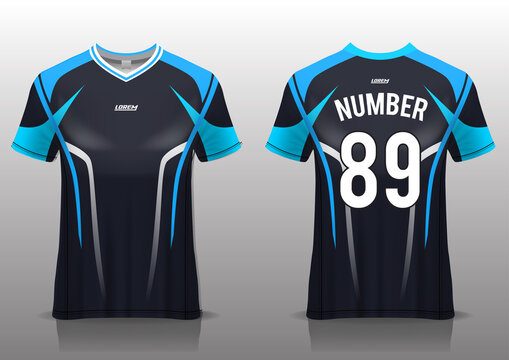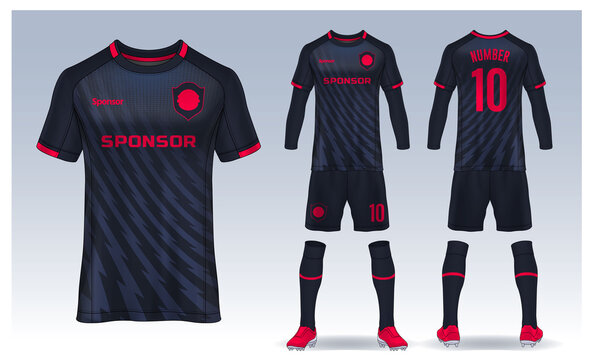
Are you confuse between buying replica or authentic soccer jerseys? We will look at Fabric, Numbers, and Logos. In the end, you’ll be able to choose the best jerseys for your soccer team and look like the stars on the field. You can also buy replica soccer jerseys ( fotbalové dresy) and save money. However, be sure to check the authenticity of the product before you buy it.
Replica vs. authentic soccer jerseys
When comparing authentic and replica soccer jerseys, you should look for the fabric type. A real jersey is usually create from cotton and is breathable and lightweight. Authentic jerseys are tighter, so they give opponents little room to grab onto the player. A replica jersey, on the other hand, has extra space in the shoulders and mid-section, making it easier to move around. It is also less clingy and dries faster.

Another difference between the two types of soccer jerseys is the fit. Authentic jerseys fit the player much more tightly around the torso and are generally more expensive than replicas. While both types of jerseys look the same, replicas are generally less breathable. A replica soccer jersey will be looser around the waist and will be easier to grab from an opponent. In addition to these differences, replica soccer jerseys are cheaper than the real thing, and they are still officially sanction.
Although replica and authentic jerseys are similar in appearance, the real thing is a different story. While authentic jerseys have a higher price, they are generally create of high-quality fabrics that wick away sweat and are laser cut for maximum airflow. While replicas are more durable, authentic jerseys are create to be worn by players and supporters. The difference is not just in design, but also in the quality of the fabric and badges.
Fabric
The material of the soccer jersey is important in determining the level of comfort and protection. Polyester is a great choice because it does not absorb water like cotton does. In addition, polyester is colorfast, which means that colors will not bleed into the shirt’s neckline. Some jerseys may include Lycra or spandex woven into the fabric. These materials stretch a great deal before breaking or tearing, but they quickly return to their original shape. This makes them great for physical soccer play.

The fabric of soccer jerseys can also be create from a variety of materials. Polyester is lightweight and durable, yet it still stretches to add additional comfort and fit. The fabric also wicks moisture away from the body and dries quickly, making even the most inexperience player feel like a champion. Polyurethane is another option, but its volume is relatively small compared to polyester. More soccer jerseys may also be create out of recycle plastic bottles or other junk materials in the near future.
Polyester is the most common material use for soccer jerseys. However, the fabric is not completely waterproof. It is important to remember that water can penetrate through the fabric of a soccer jersey, so it is important to keep the jerseys dry. If you’re concern about your soccer jersey’s comfort, you can use a hair conditioner on it. The conditioner will relax the polyester fibers and make them more pliable for stretching.
Numbers
The numbers on soccer jerseys use to indicate a specific position on the field, but they now differ slightly according to formation. For example, goalkeepers wear number one, while defenders usually wear low numbers. Strikers wear numbers nine and ten, and great orchestrators wear number 10. Although some tactical innovations have change some of these conventions, the numbers on soccer jerseys still provide a useful way to visualize a team’s layout, and they also offer an opportunity to look at soccer’s impact on society.
The concept of numbers on soccer jerseys dates back to 1928, when the first jerseys were create. In this system, the goalkeeper is the number one player, while the others are designated from left to right. The numbers are display in ascending order, beginning with the keeper. The numbers are then repeat on the sides of the goalkeeper’s jersey, from left to right, and ending with the 11th player. Traditionally, soccer jersey numbers are base on the starting formation, from right to left.
Traditionally, the number 10 is a prime example. It carries a certain cachet and is often worn by an attacking midfielder, such as Diego Maradona or Lionel Messi. However, it’s not unusual to see a number 11 or an 11 on a winger’s jersey. It’s also possible to find a number 14 jersey with a central defender’s name on it, though this is rarely the case.
Logos
The NFL has long been against sponsor logos on soccer jerseys. But a German newspaper is taking the commercialization of sport to new heights. In a recent interview with Deutsche Welle, Die tageszeitung journalist Steffen Grimberg explaine why the paper has taken the controversial step. Many professional sports teams are already force to forgo sponsor logos because the money involve has become too much. Nonetheless, the issue of logos on soccer jerseys should not be dismiss out of hand.
The first soccer team to put sponsor logos on their uniforms was the Uruguayan team Penarol, which put the sponsors’ logos on its uniforms to keep the lights on. However, the major European leagues initially resist selling advertising space on jerseys, but eventually gave in to the temptation to maximize revenue. The logos will now be placed on the left-hand side of the jersey, in a two-inch square.
Another type of soccer jersey customization involves the printing of a team’s logo. Several teams use silkscreen to print their club crests, school names, and sponsor logos. Silkscreen logos are create by pressing a special fabric paint through a stencil. Silkscreen logos look best when the logo is simple and large. They are also more noticeable in brightly colored clothing. This technique is also known for giving a three-dimensional quality to the logos.
Sizes
To purchase the correct size soccer jersey for men, you should take your measurements. You should know your height and weight, and measure the fullest part of your bust. Also, you should know the measurement of your waist. Measure it from your collarbone to your shoulder. Bend your elbows slightly when measuring your waist. Remember to take your measurements with a tape measure. Then, compare these measurements to the size chart. It is important to choose the correct size to ensure you have the right fit.

Soccer jerseys are usually fitted like a slim-fit top. You can size up if you want a looser fit. Conversely, if you want a tighter fit, you should size down. However, you should also take the level of comfort and durability of the jersey into consideration when choosing the size. A standard deviation in size is about 2cm. If you are in between sizes, go for the next size down.
Check the size guide of the jersey you want. The size chart should include information about the size of each part of the jersey. This is important because different jerseys have slightly different measurements. While the size chart on clothes shops is useful for general clothing, soccer jersey sizes vary widely. You may need to adjust the sleeves or the length of your legs in order to fit correctly. Also, note that jerseys may shrink a bit in the first few washes.